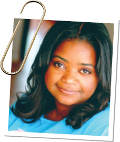Real Communicator: Octavia Spencer
real communicator
 NAME: Octavia Spencer
NAME: Octavia Spencer
OCCUPATION: Academy Award Winning Actress
I’ve always wanted to work in the film industry, though I never dreamed it would be in front of the camera. But in 1995, I got a small part opposite Sandra Bullock in the hit film A Time to Kill, and I was on my way. Since that time, I’ve had a number of roles on stage, screen, and television.
What I do want everyone reading this interview to realize is that my success is tied to a number of the topics you’re studying right now—
Vocal cues alone are incredibly important in acting. When I was the voice of “Minny” on the audio version of the book The Help (Kathryn Stockett’s New York Times bestseller), I had to study the appropriate accents, timing, and inflections to make my performance truly authentic. Later, when I played the same role for the film, I realized just how much more meaning and feeling I was able to communicate when I could use facial expressions and body movements to express my character.
Most of my roles are comedic and, let me tell you, acting in comedies isn’t a barrel of laughs. It’s incredibly challenging work. Facial expressions in particular have to be appropriate and come at just the right moment (otherwise, they aren’t at all funny). Often there are ten different facial expressions I have to produce in less than one minute to show surprise, hurt, outrage, confusion, acceptance, determination, confidence, liking, disgust, and pleasure. Oh, and it has to appear natural, too.
In addition, the way I tilt my head or hold my body changes the information I’m trying to convey. For example, I played Dr. Evilini, a witch with dual personalities, on Wizards of Waverly Place. As one personality, my head was bent, and my voice low pitched with a diabolical, screeching laugh. The other personality had a normal voice, and I kept my body erect, though my eyes were always wide with expression. Because the show’s target audience was primarily comprised of children, every movement was exaggerated to ensure its comedic value.
At the end of the day, I am truly grateful to be doing something that I absolutely enjoy—